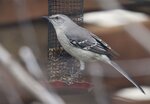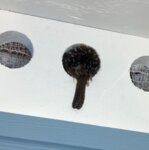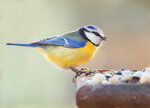



Several weeks ago, I received a few photographs sent by reader John Hutchings. John noticed that a single bird was spending its night in the roof vents of his house (see photo 1), choosing a different vent each night. John wondered about the identity of this bird, since he never saw it enter or exit the vent. He could just see its tail sticking out.
I guessed that the mystery bird was a Chestnut-backed Chickadee (Black-capped Chickadees have white outer tail feathers, and there were no white feathers on this bird). That’s because in winter, Chickadees feed on spider nests, and I thought perhaps the bird was hunting, and while looking for spiders, accidentally found a comfortable overnight site.
Chickadees are renowned for their memories. They have been observed to take sunflower seeds from feeders and hide them in a variety of places. When snow has covered the ground, branches, and other hiding places the birds seem to remember the location of the seed caches and recover them easily. (Of course, ones that cannot remember are much less likely to survive). Chickadee brain studies document that the memory portion of a bird’s brain actually increases in size as the fall seed-hiding tasks are underway.
John continued watching to see the bird emerge, but so far, no luck. One of his later photos, however, shows faint horizontal stripes on the bird’s tail (see photo 2). Aha! It’s a wren, but I’m still unsure of the species. (There are 9 species of wrens in North America, but only three are likely to be wintering here.)
This story demonstrates something ornithologists are learning more about – that birds, even the little ones, have impressive brains. They can, at times, innovate completely new behaviors. As I searched for information about bird brains, my smartphone linked me to a great example of innovative bird “culture.” In the 1920’s one milk customer in a town in rural England reported that someone was removing the lids of unhomogenized milk bottles and eating the cream from the top. Was it the neighborhood hooligans?
After some investigation, it was determined that the culprit was a Blue Tit (a chickadee-like species). Soon other Blue Tits had learned the trick, the theft problem spread throughout the village and, in a matter of a few years, had become widespread throughout the county. Eventually, improved bottle caps solved the problem. So now I’m wondering if other birds might see this industrious wren using roof vents and follow its lead. Such a step would suggest another example of a shared bird “culture.”
On another day, my smartphone insisted that I must read about the Superb Lyrebird, a woodland resident of Southeastern Australia. The males of this species sing to attract females into their territory. They are also talented mimics. Once a male thought he could attract a mate if he sang the Kookabura bird’s song. He did it so well that a male Kookaburra flew in right over the observer’s head. You have to listen to this bird.
This reminded me of a birding walk in Georgia some years back. It was May and I was excited to find some of the more unusual eastern U.S. warblers. From nearby bushes I heard multiple unfamiliar songs, one after another. A whole mixed flock of unfamiliar eastern birds?
And then, a lone singer popped up in full view and continued his concert. It was a male Northern Mockingbird, trying out his full repertoire of borrowed songs. This species – a medium-sized gray bird with bold white wing bars and a long tail – ranges throughout the United States but, unfortunately, is very uncommon in Western Washington.
However, if you have a phone as smart as mine you can easily find information about it.
George Walter is environmental program manager at the Nisqually Indian Tribe’s natural resources department; he also has a 40+ year interest in bird watching. He may be reached at george@theJOLTnews.com
Photos for this column are provided by Liam Hutcheson, a 16-year-old Olympia area birder and avid photographer.
3 comments on this item Please log in to comment by clicking here
Terrilovesanimals
I love birds and totally enjoyed this! I have a birdfeeder and am always amazed and awed when a new type shows up. In the last year I have even started getting doves. And I have found that birds are smart enough to trust the person that talks to them and feeds them!
Friday, March 8 Report this
rockyw98502
Hi George,
Good detective work on that "mystery" bird; I'm guessing it's either a House or Bewick's Wren given the length of the tail. Did he mention whether the bird flicked its tail? I've had both visit my yard (infrequently, but checking in)....
Betty Watson
West Olympia
Friday, March 8 Report this
wildnature
Dear George
Your articles brighten my day, as do the wonderful creatures you write about. Are the herons about ready to occupy nests down at Woodard Bay? I went to see them last Sunday, but the nests were all quiet and no herons sighted.
Wild Nature
Friday, March 8 Report this